-

部编人教版六年级上册《古诗三首:浪淘沙》 说课稿
一、说教材《浪淘沙》是六年级语文上册第六单元中的一首古诗,这是一首描写黄河雄伟气势的著名诗篇。诗开篇与众多的黄河诗一样,着力描写九曲黄河大浪淘沙之势。紧接着著张骞穷河源遇牛郎、织女的典故,再把“黄河之水天上来”更形象化。在王之涣、李白之外,另辟一条境界,增添了一层奇妙的神话色彩。全诗立意新颖,思想深刻,明快清新。表现了诗人奋发有力的精神和豪迈浪漫的气魄。二、说学情学生在经过了五年的语文学习后,已经形成了一定的诗歌的学习方法和学习步骤,能通过资料以及对背景的了解对诗歌的大意进行自学理解。但同时,学生还存在理解诗歌有时不够深入,缺乏自己的思考过程,特别是在体悟诗歌情境上有着明显的不足。因此,教师在教学中应着力培养学生联系上下文赏析诗歌的意识和习惯的同时,需帮助学生在头脑中更好的建构起诗中情境画面,让学生由诗句产生丰富的联想,体会诗歌的意象美。
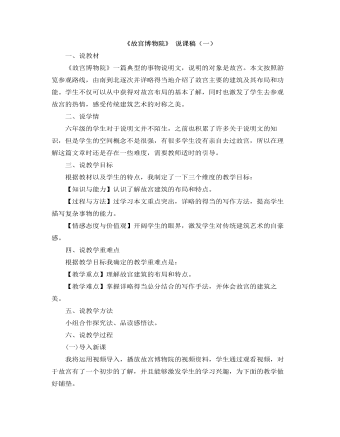
部编人教版六年级上册《故宫博物院》说课稿(一)
一、说教材《故宫博物院》一篇典型的事物说明文,说明的对象是故宫。本文按照游览参观路线,由南到北逐次并详略得当地介绍了故宫主要的建筑及其布局和功能。学生不仅可以从中获得对故宫布局的基本了解,同时也激发了学生去参观故宫的热情,感受传统建筑艺术的对称之美。二、说学情六年级的学生对于说明文并不陌生,之前也积累了许多关于说明文的知识,但是学生的空间概念不是很强,有很多学生没有亲自去过故宫,所以在理解这篇文章时还是存在一些难度,需要教师适时的引导。三、说教学目标根据教材以及学生的特点,我制定了一下三个维度的教学目标:【知识与能力】认识了解故宫建筑的布局和特点。【过程与方法】过学习本文重点突出,详略的得当的写作方法,提高学生描写复杂事物的能力。【情感态度与价值观】开阔学生的眼界,激发学生对传统建筑艺术的自豪感。
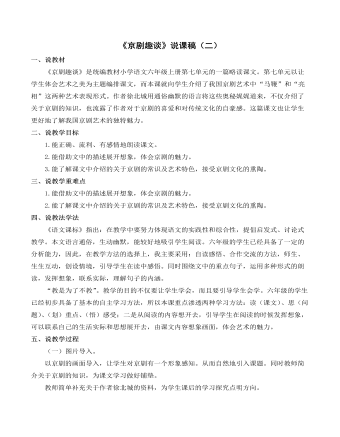
部编人教版六年级上册《京剧趣谈》说课稿(二)
一、说教材《京剧趣谈》是统编教材小学语文六年级上册第七单元的一篇略读课文。第七单元以让学生体会艺术之美为主题编排课文,而本课就向学生介绍了我国京剧艺术中“马鞭”和“亮相”这两种艺术表现形式。作者徐北城用通俗幽默的语言将这些奥秘娓娓道来,不仅介绍了关于京剧的知识,也流露了作者对于京剧的喜爱和对传统文化的自豪感。这篇课文也让学生更好地了解我国京剧艺术的独特魅力。二、说教学目标 1.能正确、流利、有感情地朗读课文。 2.能借助文中的描述展开想象,体会京剧的魅力。 3.能了解课文中介绍的关于京剧的常识及艺术特色,接受京剧文化的熏陶。三、说教学重难点1.能借助文中的描述展开想象,体会京剧的魅力。2.能了解课文中介绍的关于京剧的常识及艺术特色,接受京剧文化的熏陶。

部编人教版六年级上册《开国大典》说课稿(二)
一、说教材《开国大典》是国家统编教材语文六年级上册第二组课文的第三课精读课文,本组教材以“重温革命岁月”为专题。《开国大典》记叙了1949年10月1日在首都北京举行的开国大典的盛况,按照盛典进行的顺序,通过对盛典一个个场面的描写,表达了中国人民对新中国的诞生无比自豪、激动的心情,展现了中华人民共和国的缔造者们特别是毛泽东的领袖风采。二、析学情,说目标六年级是小学语文教学的第三学段,学生经过前五年的学习,已经具有较强的独立识字能力和朗读能力,并且掌握了理解词语的方法,在读中能够初步体会作者表达的思想感情,并有了一定的生活经验和资料搜集能力,这些为本课的学习方法指导和感情的升华奠定了基础。

部编人教版六年级上册《狼牙山五壮士》说课稿(二)
一、教材分析课文基本内容:本组课文以“爱国主义教育”为主题,内容展现的是在中国近代史上,中华民族受尽屈辱,优秀的英雄儿女们奋起抗争的革命斗争故事,饱含了强烈的民族精神和爱国热情。教师通过课文内容的讲解和激昂的朗读带领学生进入曾经的战争年代,体会战士们的爱国热情和他们视死如归的英雄气概,通过课文的学习激发学生强烈的爱国情怀,深化文章的主题。二、教法和学法采用讲授法、讨论法、读书指导法和演示法相结合的教学方法,引导学生通过自主学习课文和同学谈论交流等方式发现问题、提出问题、解决问题,学生在学习的过程中要加强朗读,做到“以读促情、以读感悟”。另外,教师配合运用多媒体课件展示和板书等方法来促进课堂教学。

部编人教版六年级上册《三黑和土地》说课稿
一、说教材 《三黑和土地》是统编教材小学语文六年级上册第六单元的一篇略读课文。这是一首现代诗歌,描述了翻身农民三黑重获土地的喜悦心情,对土地的无比热爱之情,以及有了土地后对美好生活的憧憬和向往。 本文分为三个部分:第一部分总体写出三黑得到土地后,视若珍宝、爱不释手的情感。认真地侍弄土地:仔细地翻地,来回地耙地,把土地弄得非常松散,简直像一张柔软的床。非常适合种子在上面生长。第二部分介绍三黑把荞麦种子播种到地里,看到麦苗的良好长势,听到地里的蝈蝈叫,想起心酸的童年生活,第三部分,展望未来,向往美好的生活。 二、说教学目标 1.训练学生正确理解和运用语言文字的能力。 2.掌握作者比喻的修辞手法。 3.了解三黑对土地的热爱和对美好生活的向往之情。

人教版高中语文必修3《语文学习的自我评价》教案
一、语文学习中学生自我评价能力的培养1.营造氛围,培养学生自我评价的意识。学生自我评价能力是教师长期培养的结果,而保护学生自我评价的热情,更是持续自我评价的保证。在我们的实际教育教学中,教师一直处于评价的绝对主体,很少去关注学生自我评价意识和能力的培养,学生常常不理解:为什么要认真听讲?为什么书写要工整、为什么发言要积极?为什么老师、父母对考试分数会有那么高的要求?当前出现的学生许多诸如“离家出走”、“毒杀亲人”等教育、行为、品德方面的问题,我想其中除了家长、教师的评价意识和评价艺术等原因之外,学生的自我评价意识的缺乏是根本的原因。所以我认为,学生自我评价意识的培养刻不容缓。(1)热情鼓励,提供成功的心理体验。在教学过程中,教师要善于发现、肯定学生自我评价的点滴进步,对于他们每一点进步都要真诚热情地鼓励。让学生觉得我这么做,这么想是对的。让学生在教师的鼓励中体会到强烈的爱,感受到自己的进步,增强自己的信心。“心若在,梦就在!”教师的热情鼓励是一种强大的催化剂,促使学生在学习中乐于自我评价。

人教版新目标初中英语七年级下册Don’t eat in class教案2篇
Don’t fight. =You can’t fight. (板书,教读)教师把这些句子板书在黑板上,并请学生大声整齐地读祈使句和“can’t”句型,并让学生注意两种句型表达形式的不同和转换,“Don’t …=You can’t…”;并对学生说:These are our school rules. (板书,教读) You can’t break the school rules. Don’t break the school rules.(板书,教读)步骤3 :Practicea. T: Now, each of the students is breaking one of these rules.Please finish 1a.学生看图,完成1a的内容,检查答案并大声朗读校规。b. 听录音,完成1b,选出四位学生都违反了哪条校规;听之前,学生要读会英文名。c. 请两位学生朗读1c部分的句型;要求学生两人一组对话表演,SA扮演外校转来新生,SB告知本校校规。(学生可经过讨论,多说出他们想到的校规,不必只限于书上;教师应给予帮助)2) 第二课时(2a~4)步骤1 :warming up of revisionT: What are the rules at your school?学生使用“can”或祈使句表达各条校规;其中老师可引出“eat in the cafeteria outside”的表达。步骤2 :Practicea.T: Christina is an exchange student. She doesn’t know the rules. Let’s listen, what activities they’re talking about?学生听第一遍时,完成2a;第二遍时,完成2b;b. 请学生领读2c部分,看着2a完成的表格,理解2c活动的要求;分成小组针对2a进行问答;

人教版新目标初中英语七年级下册What do you think of game shows教案
五、教学Section B-2c1. Pair work: What do you think of the belt/sunglasses/…? What does your father/mother/… think of your scarf/belt…?2. Group work(1). Teacher shows some different kinds of school uniforms (制服)and asks : “ What do you think of your school uniforms? If you have a chance to choose your school uniforms, what kind would you like to choose?”(2). Discuss in groups.(3).Get some Ss to report in class.说明:这一步旨在让学生运用已有的语言知识谈论对事物的看法和意见,并简单阐明理由,培养学生的主动思维能力和运用英语的能力。六、教学拓展调查电视节目的收视率任务:调查你周围的人对现在各种电视节目的反响。活动过程:1.教师布置任务,让学生调查周围的人(包括他的亲戚朋友和邻居)喜欢收看哪方面的电视节目。2.学生进行调查活动,运用本单元所学的句型What do you think of….? (Why?)What's your favorite game shows?What do you think of talk show?I doesn’t mind it.I like it.I love it.I can’t stand it.3.记录下排在前10位的TV Program,填写调查表,比较其收视率。
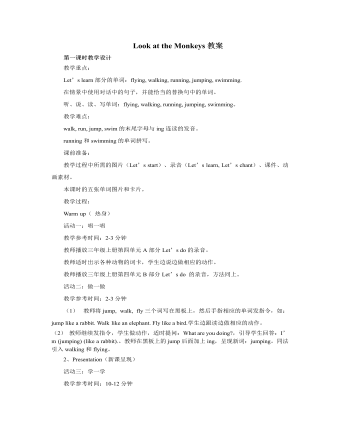
人教版新课标PEP小学英语五年级下册Look at the Monkeys教案
教学参考时间:5分钟(1)教师课前在教室里藏好一些动物和人物的图片。(2)给全班学生一分钟时间寻找。(3)请找到图片的学生根据图片上的人物或动物正在做的动作表演对话。活动七:猜一猜教学参考时间:5分钟(1)教师一只手拿一张图片,另一只手用白纸遮住图片,一边慢慢抽动白纸,一边问:What are the…s doing? 学生用They are…猜图片中的内容。(2)猜对的学生上台主持游戏。(3)教师也可以在白纸上剪几个圆洞盖在图片上,慢慢移动白纸的位置让学生猜白纸下面图片的内容。(4)也可以分组利用词卡做该游戏。4、Consolidation and extension (巩固与扩展)活动八:练一练教学参考时间:5分钟(1)活动手册Ask and write. 让学生看一看两个表格,找规律做问答,然后再把表格中所缺单词写出来。(2)活动手册Let’s find out.让学生仔细观察两幅图找出不同的地方,并用英语表达出来。活动九:小结教学参考时间:1分钟本课我们学习了如何询问他、她、它们正在做什么What are they doing? 及回答:They are…5、板书
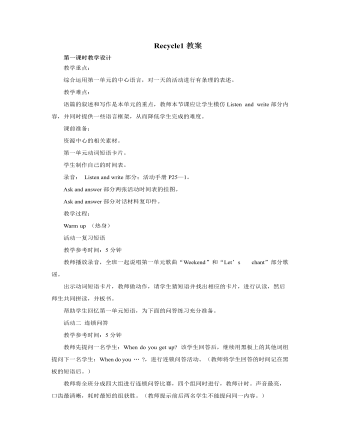
人教版新课标PEP小学英语五年级下册Recycle1教案(内容详细)
学生搜集中外重要节日及部分中外名人的生日所在的月份。教师准备相关节日及部分中外名人的图片或音像资料片。教师课前准备Let’s find out2的配图画好春、夏、秋、冬四个方框。录音:Listen and number。教学过程:Warm up (热身)活动一复习单词教学参考时间:3分钟(1)教师播放Let’s chant部分的歌谣,学生听一遍后跟唱。(2)出示带有各个月份特征的单词卡片。学生看图说出单词,并一起拼读其缩写形式。帮助学生在有节奏的说唱中巩固记忆单词,为在后面活动中学生能够熟练应用作铺垫。活动二 复习句子教学参考时间:5分钟(1)师生同唱Let’s chant部分歌谣“When Is Your Birthday?”。(2)教师引导学生看歌谣下面的翻滚过山车的动画,师生进行问答,如:When is the rabbit’s birthday? It’s in May. 等。教师示范后请学生进行Pair work,也可以展开竞赛的形式进行“连锁问答”。巩固有关生日问答的语句,为Let’s find out1的活动做准备。
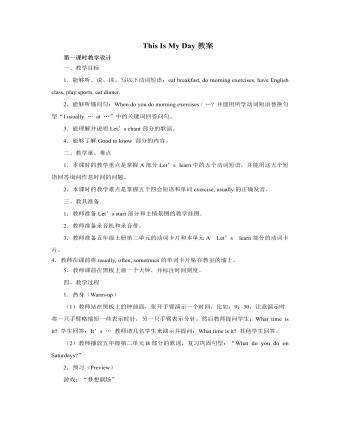
人教版新课标PEP小学英语五年级下册This Is My Day教案
学生初步了解对话内容,在描述中培养学生的语言运用能力。(2)教师让学生自己阅读本部分对话,不理解的生词和句子可以和同学或老师共同商讨。(3)教师帮助学生理解句子:“The weather report says it’s going to rain tomorrow. I can’t play football in the rain. I can’t go hiking, either. Let’s watch TV together.”出示图片:1) 晴天,Zoom在踢足球,图下显示:today;2)天在下雨,Zoom和Zip在屋里看电视,图下显示:tomorrow。与学生展开对话T:What’s the weather like today? S:It’s fine/ sunny. T:What does the weather report say about tomorrow?S:It’s going to rain.T:The weather report says it’s going to rain tomorrow.(呈现句子)(学生重复句子The weather report says it’s going to rain tomorrow.,并说出意思。)T:Can you play football in the rain?S:No,I can’t.T:Can you go hiking ?S:No,I can’t.T:In the rain, we can’t play football. We can’t go hiking, either. (呈现:either)学生跟读either,感悟单词的用法,教师讲解意思:(不......),也不...启发学生用either说两句话:In the rain, I can’t ... I can’t ..., either,从而在应用中巩固单词的读音和用法。

人教版新目标初中英语七年级下册How was your weekend教案2篇
Teaching Goal:1. General aims:Talk about recent past events2. Particular aims:A. Language Focus.Talk about recent past events and think of the past events.B. Language goalsHow was….?It was …What did …do over the weekend?C. Language structures:(1). How was your weekend? I was great. Pay attention to no form.(2). What did you do over the weekend? I played soccer. We went to the beach.D. Useful words and phrases:Words: was, did, went, beach, over, project, test, wasn’t, false, number, geography, spend, week, most, mixture, their, had, little, cook, read, saw, change, everyone, sit, sat, no, anythingPhrases: did one’s homework, played soccer, cleaned my room, went to the beach, played tennis, went to the movies, on Saturday morning, over the weekend, cook … for, what about, do some reading, have a party, talk show, go shoppingE. Grammar language:Present simple past tenseRegular and irregular verbsF. Learning strategies:Tour and holidaysG. Interdiscipinary:H. Emotion and manner:Teaching time: 5 periodsTeaching procedures:Period One教学步骤、时间 教师活动 学生活动 媒体应用Step 1Free talk 3’ Ask some questions like:Who’s on duty today?What’s the weather like? Answer and talk about something.让同学们回答下列问题1. Do you like weekend? (Let some students answer)It takes them three minutes to talk about the question.2. Why do you like weekend? (let the students answer) Most of the students like the weekend此时教师用汉语问:“在周末期间问你干了什么?这句话用英语这么回答?Let the students guess.At last the teacher give them right answer3. What did you do over the weekend?(板书、学习)

人教版新目标初中英语七年级下册What does he look like教案3篇
所需要用到的句子:Who is that?That is Jack. I like him.Why do you like him?I like him because he is interesting.Task 4: 设计理想中的人类Step one: 设计理想中的人类的外貌。把全班同学分成若干小组,学生可以边说边在纸上画出他们的模样。Step two: 设计理想中人类的性格。学生们可以把那些能描述性格的单词写在图画的旁边。Step three: 每组选出一名同学,其他同组同学提问,他作简单回答,并说明原因。所需用到的句子:What does he or she look like?He or she ...What is he or she like?He or she is ...Why?Because ...Task 5: 挑战性活动调查性格是天生的还是后天形成的,让每个同学回家去调查一下自己成长过程中性格是否有变化,具体是怎样的,为什么会这样? Teaching Aims:1. Enable students to have a general understanding of how to talk about people's physical appearance.2. Enable students to tackle some essential vocabularies and patterns about describing people. Provide them with necessary skills and methods.3. Create various chances for students to describe the persons they're familiar with, such as classmates, family members, teachers, idols, etc.

人教版新目标初中英语七年级下册Where is the post office教案2篇
Period 2 (3a----Section B 2c)Preview(Pre-task): Key points: What laAdd another information about their pen pals----their language on the cardnguage does she/he speak?She/He speaks....Does she/he have any brothers and sisters? Does she/he speak English?Preview(Pre-task): Add another information about their pen pals----their language on the cardKey points: What language does she/he speak?She/He speaks....Does she/he have any brothers and sisters? Does she/he speak English?Step 1 Revision1.Revisionand dictation of the new words 2.Revise the drills they learned yesterday.(by pairwork and grammar exercise)Step 2 Leading-inT has a conversation with one student. The conversation is following:---Do you have a pen pal?---Yes, I do.---What's your pen pal's name? ---His/Her name is....---Where is your pen pal from? ---He/She is from...---Where does he/she live? ---He/She lives in....---What language does he/she speak?He/She speaks...Write the new words on the Bb. They are following: EnglishChineseJapaneseFrenchStep 3 LearnLearn the new words with the whole class.Finish 3a with the students3b Pairwork T still does an example with one student Then the Ss practise in pairs. The example is following:--Curry Muray is my pen pal. He is from the United States.---What language does he speak?

人教版新目标初中英语七年级下册I ’d like some noodles教案
教学过程Step 1: warming-up Sing a song---------“food and drink” Step 2: Revision1 Dictation2 Revise: What kind of noodles would you like?I’d like …What size bowl of noodles would you like?I’d like…Step 3: Presentation1 show pictures of food, ask students say the words.2 Students read the newspaper ad in 3a. Fill in blanks with words in the box. Then read the ad together, the teacher explains some difficult language points.3 Check the answers Step 4 PracticeAsk students to finish 3b in the same way according to 3a. Students read the short passage and fill in the blanks .At last, check the answers.Step 5 productionAsk students to write their own ad for dumplings, noodles, drinks, and other foods they know. Then ask students to read their partner’s ad. Then order food and drink from their partner.Step 6 Home workGroup work – make an ad about “food and drink”

人教版新目标初中英语七年级下册I want to be an actor教案2篇
三、教学建议第一课时:1. Lead in (Vocabulary)A) Before class, teacher should collect some pictures of working places. For example: Bank, TV Station, Restaurant, Police Station, Hospital ...B) In class, show students the pictures (PowerPoint, OHP). Ask students to tell the name of the working places and the name of the jobs.Shop assistant, doctor, actor, reporter, police office, waiter, bank clerk, studentC) Do exercise 1a and 3a.2. Bingo GameAsk groups of students to make up pairs of cards with a job on one and the related workplace on the other. For example, waiter / restaurant, teacher / school, doctor / hospital. Encourage students to use both the job / workplace combinations in the book and the ones that students came up during class discussions. Be sure they have twice as many sets of cards as there are students in the group. They can make two sets of cards for a single job / workplace, if necessary. Then have each group mix up its set of cards and hand their cards out in random order. Each time a student gets a pair of cards that match, he or she can lay these cards down. The goal is to have no cards in your hand at the end.3. Task OneA) Ask students to work in pairs and ask the partner what does he / she want to be in the future.e. g. :What do you / does he / does she want to be?I want to be a.Why?Because it's (adj).B) Vocabulary: Section B, 1a4. Homework 1.2.

人教版新目标初中英语七年级下册Where is your pen pal from教案
2.1Match the country with the language.Step II Reading3a? let the students read the letter fast and answer the questions.? Let the students ask more questions about the letter as possible as the can.Step III Writing3b.Step IV. Pairwork2cStep V Listening2a, 2bStep V. HomeworkExercises book(1) P3Exercises book (2) P3Period FourStep I . Dictate the words and sentences in Unit1.Step II. Self-checkStep III. Check the answers for Exercises book in the unit.Step IV. Home workRevise and preparation for unit 2.教学反思:通过本单元的学习,学生基本可以谈论人们的国籍,居住城市及其所说的语言,通过书信方式去介绍自己并寻找笔友。但在涉及到国外的一些城市时,学生对这方面的知识相对欠缺,能介绍的城市并不多,也反应出学生课前预习不充分,这跟学生学习条件也有关,大多数学生无法通过网络获取所需信息。因此,在以后的教学中要多指导学生通过计算机网络获取信息,拓宽知识面。

人教版新目标初中英语七年级下册Where did you go on vacation教案
句型: Where did you go on vacation? I went to summer camp.Did she go to Central Park?Yes,she did.No, she didn’t语法:一般过去时特殊疑问句、一般疑问句及肯、否定回答。课时安排4课时第一课时:Section A:la,1b,lc,2a,2b,2c 第二课时:Section A:3a,3b,4第三课时:Section B:1,2a,2b,2c第四课时:Section B:3a,3b,3c,4 and Self Check第一课时教学目标掌握描写假期生活的形容词。假期里自己所做事情的简单表达。谈论假期做的事情及当时情况。谈论假期时旅游的天气,旅游者以及食物等。教学过程一、导入播放一首英文歌曲:Let’s travel 说明:通过让学生听节奏欢快迪斯尼英语歌曲Let’s travel.引入本节课谈论的话题vacation and travel. 让歌曲使学生的思维活跃,增强课堂气氛,激发学生提高学习英语的兴趣。T:How is the trip ?Ss : It’s pretty good/ happy/exciting /relaxing/busy/dangerous/ fantastic说明:这个问题是为了操练形容词。建议让多个Ss作答。鼓励他们用不同的形容词。上述个别形容词本应在第二课时中出现,但可以在warming-up中第一次非正式出现。这些形容词也可在老师的评价语中适时出现,以加深学生对词汇的印象。

人教版新目标初中英语七年级下册Why do you like koalas教案2篇
单元整体说明(一)单元教材分析本单元的核心话题是描述动物和表达个人喜好,以及句式why do you like…? Because…。这也是本单元的教学重点。通过本单元的学习,学生应能较流利地运用所学词汇和句型描述动物,表达个人喜好。(二)单元知识结构1.词汇动物名称 tiger, elephant, koala, dolphin, etc.词汇描述性形容词: smart, cute, ugly, clever, shy, etc.国家名: Australia, South Africa2.句型Why do you like koala hears? Because they are cute.Where are pandas from? They're from China.What animals do you like? I like dolphins.(三)单元整体目标1.Master the vocabulary2.Master and use: Why do you like koalas? Because they am cute.Where are pandas from? They're from China.What animals do you like? I like dolphins.(四)单元教学重难点一览(五)单元学情分析学生此前已经学过由why, where, what 引导的特殊疑问句句型,具有了学习本单元知识的认知前提。形形色色的动物能激发学生的好奇心,产生了解它们的欲望,这有利于本单元知识的教学和学生学习兴趣的培养。